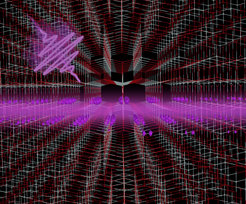Shedding light on light absorption: titanium dioxide unveiled
MPSD scientists have uncovered the hidden properties of titanium dioxide, one of the most promising materials for light-conversion technology.
The anatase crystal form of Titanium dioxide (TiO2) is one of the most promising materials for photovoltaic and photocatalytic applications nowadays. Despite years of studies on the conversion of light absorbed by anatase TiO2, into electrical charges, the very nature of its fundamental electronic and optical properties remained still unknown.
Scientists from the MPSD (Max Planck Institute for the Structure and Dynamics of Matter) at CFEL (Center for Free-Electron Laser Science) in Hamburg, together with their international partners at EPFL, Lausanne used a combination of cutting-edge steady-state and ultrafast spectroscopic techniques, as well as theoretical simulation tools to elucidate these fundamental properties of anatase TiO2. Their work is published in Nature Communications.
Anatase TiO2 is involved in a wide range of applications, ranging from photovoltaics and photocatalysis to self-cleaning glasses, and water and air purification, all of which are based on the absorption of light and its subsequent conversion into electrical charges. Given its widespread use in various applications, TiO2 has been one of the most studied materials in the twentieth century, both experimentally and theoretically. Paradoxically, the very nature of what it is that actually absorbs light was unclear!

When light is shined on a semiconductor material, either free negative charges (electrons), positive charges (holes) or bound electron-hole pairs (excitons) are generated. Excitons can transport both energy and charge and are the basis of an entire field of next-generation electronics, called “excitonics”. So far we have lacked the ability to clearly identify the nature and properties of the physical object that absorbs light and characterizes the properties of TiO2.
The group of Prof. Angel Rubio at the Theory Department of the MPSD along with its international collaborations have solved this problem using a combination of state-of-the-art first-principles theoretical tools along with cutting-edge experimental methods: steady-state angle-resolved photoemission spectroscopy (ARPES), which maps the energetics of the electrons (band-structure) along the different axis in the solid; and spectroscopic ellipsometry, which determines the macroscopic optical parameters (dielectric constant, etc.) of the solid with precision and ultrafast two-dimensional deep-ultraviolet spectroscopy, which is for the first time used in the study of materials. They discovered that the threshold of the absorption spectrum is due to a strongly bound exciton, which exhibits two remarkable novel properties:
a) it is confined on a 2-dimensional (2D) plane of the 3-dimensional lattice of the material. This is the first such case ever reported;
b) this 2D exciton is stable at room temperature and robust against defects, being present in any type of TiO2-single crystals, thin films, and even nanoparticles used in devices.
This “immunity” of the exciton to long-range structural disorder and defects implies that it can store the incoming energy, in the form of light, and guide it at the nanoscale in a selective way. This promises a huge improvement compared to current technology, in which the conventional excitation schemes are extremely inefficient because the absorbed light energy is not stored but dissipated as heat to the crystal lattice. “The use of cutting-edge experimental techniques and theory allows us not only to understand but also design and create new, even more efficient materials for energy applications” says Adriel Domínguez.
Furthermore, the exciton parameters can be tuned by a variety of external and internal stimuli (temperature, pressure, excess electron density), promising a powerful, accurate and cheap detection scheme for sensors with an optical read-out. “Given the cheap and easy to fabricate anatase TiO2 materials, these findings are crucial for such applications and beyond, to know how electrical charges are generated after light is absorbed”, says Prof. Majed Chergui from EPFL “These charges are the key players in solar energy conversion and photocatalysis.” Prof. Angel Rubio emphasizes that this sort of studies, resulting from the close collaboration between theoretical and experimental groups, are essential in order to unveil the microscopic origin of the light-energy conversion and energy transfer processes in materials of relevance for photovoltaic and photocatalytic applications and for the design of new artificial photosynthetic inorganic materials. “We’ll continue working with our international partners in EPFL in Lausanne to understand, even better, how this kind of bulk materials as well as many other low-dimensional oxide nanostructures behave when driven out of equilibrium by external stimuli such as light” he finalizes.
This work was carried out in a collaboration of the Max Planck Institute for the Structure and Dynamics of Matter (MPSD) with the EPFL’s Lausanne Centre for Ultrafast Science (LACS and the Institute of Physics (IPHYS), the University of Fribourg, the Università Campus Bio-Medico di Roma, the Center for Life Nano Science in Università di Roma “La Sapienza”, and the Universidad del Pais Vasco. It was funded by the Swiss National Science foundation (SNSF; NCCR:MUST), the European Research Council Advanced Grants “DYNAMOX” and “Qspec-Newmat”, Grupos Consolidados del Gobierno Vasco and the Austrian Science Fund.












